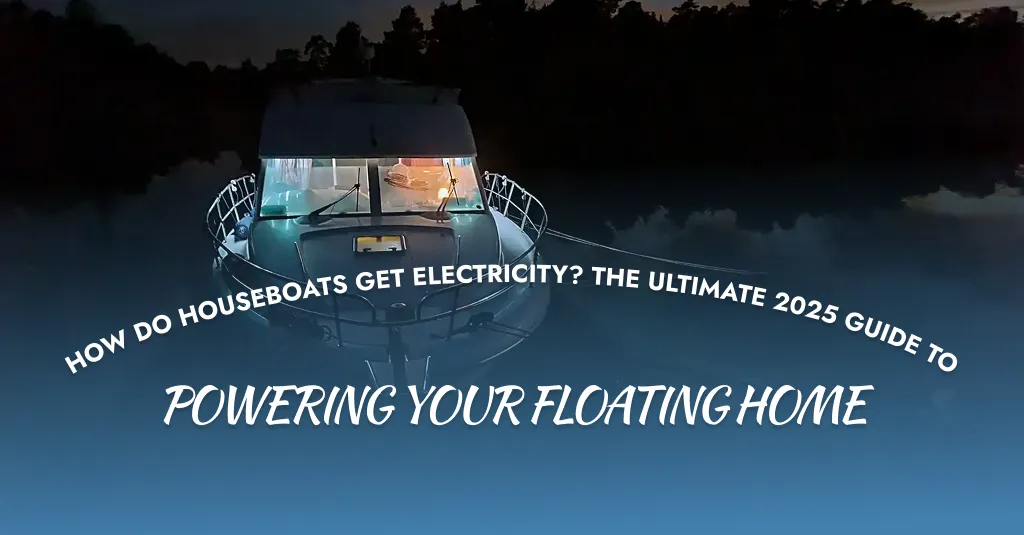
How Do Houseboats Get Electricity? The Ultimate 2025 Guide to Powering Your Floating Home
Living on a houseboat is a dream for many the gentle sway of the water, stunning sunrises, and the freedom to change your backyard anytime you like. But one big question stops many people in their tracks: how do houseboats get electricity?
Unlike a house on land, you can’t just plug into the city grid and forget about it. Instead, powering a floating home takes a bit more creativity and a blend of old-school know-how and modern tech.
In this complete 2025 guide, we’ll break down exactly how do houseboats get electricity, explore the best ways to generate and store it, explain common setups, share insider tips, and help you decide what system works best for your dream boat life.
Whether you’re planning to rent a houseboat for a vacation, move aboard full-time, or design your own custom liveaboard, this guide will shed light on how you’ll keep the lights and everything else running smoothly.
Understanding the Basics: How Do Houseboats Get Electricity?
Let’s get this straight: houseboats need electricity for lights, appliances, air conditioning, heating, cooking, navigation equipment, and charging devices. But unlike traditional homes, houseboats rely on a combination of power sources.
The three main ways houseboats get electricity are:
-
Shore Power Connection.
-
Onboard Generators.
-
Renewable Energy (Solar Panels & Wind Turbines).
Most modern houseboats use a hybrid of all three, plus an inverter and battery bank to store power for when you’re off the grid.
Shore Power: The Most Common Solution
Ask any liveaboard boater how do houseboats get electricity when docked, and they’ll say, “shore power.”
When you’re moored at a marina, you can hook up your houseboat to a marina power pedestal, an onshore electrical outlet that supplies AC power to your boat. It’s just like plugging your RV into a campground hookup.
How Shore Power Works:
-
A heavy-duty marine-grade cable connects your houseboat to the pedestal.
-
Common options are 30-amp or 50-amp hookups.
-
Shore power provides 120V or 240V AC, just like a house.
-
The power runs through the boat’s electrical panel and outlets.
-
Many marinas charge a flat fee or metered rate for electricity.
Benefits of Shore Power
-
Reliable and constant electricity.
-
No need to run a noisy generator.
-
Supports high-wattage appliances like AC units, stoves, and water heaters.
Limitations
-
You need to be docked at a marina.
-
If you want to anchor out for days or weeks, you’ll need other options.
Marine Generators: Powering Up When You’re Off-Grid
The next answer to how do houseboats get electricity comes in the form of a marine generator.
A generator is like carrying your own little power station onboard. When you’re anchored in a remote cove or mooring field without shore power, you crank up the generator to produce electricity.
How Marine Generators Work:
-
Run on diesel, gasoline, or propane.
-
Sizes vary: small portable units to large built-in marine diesel generators.
-
Produces AC power that runs directly to your boat’s electrical system.
-
Charges your battery bank at the same time.
Benefits of Generators
-
Independence: go off-grid anytime.
-
Reliable backup during storms or shore power outages.
-
Provides enough juice for power-hungry appliances.
Drawbacks
-
Noise: some generators are loud.
-
Fuel cost and storage.
-
Maintenance required to keep them in top shape.
Many full-time liveaboards rely on a generator + battery bank combo so they can run the generator for a few hours daily and store enough power to last until the next run.
Renewable Energy: Solar Panels and Wind Turbines
Ask any eco-minded boater how do houseboats get electricity, and they’ll say “solar panels!”
Today’s houseboats increasingly use renewable energy for daily needs. Solar panels mounted on the roof or deck capture the sun’s rays and convert them into DC power. Some houseboats add small wind turbines to generate extra power when it’s breezy.
How Solar Panels Work on Houseboats:
-
Panels charge a houseboat battery bank during daylight.
-
An inverter converts the DC battery power into AC for your appliances.
-
Solar controllers manage charging to prevent battery damage.
-
Many setups include 400–1,200 watts of panels, depending on space.
Benefits of Solar Power
-
Silent, clean energy.
-
Lower fuel costs.
-
Keeps batteries topped up when you’re away from the dock.
Challenges
-
Limited roof space on some boats.
-
Output depends on sun exposure.
-
May not meet high power demands alone.
Most liveaboards combine solar with a generator for backup, the perfect off-grid setup!
Understanding the Role of Inverters & Battery Banks
So, how do houseboats get electricity to outlets when not plugged into shore power? The magic happens through an inverter and a battery bank.
Houseboat Battery Bank:
-
Stores DC power generated by solar panels, generator, or alternator.
-
Deep-cycle marine batteries are common.
-
Capacity measured in amp-hours (Ah).
Inverter:
-
Converts 12V or 24V DC power from batteries into standard 120V AC power.
-
Powers laptops, appliances, lights, TV, and more.
A good inverter/charger system automatically switches between shore power, generator, and battery modes for seamless power management.
Different Houseboat Power System Examples
Let’s look at how real boaters answer the question, how do houseboats get electricity, with three typical setups.
Marina Queen:
-
Docked year-round.
-
Always plugged into shore power.
-
Rarely uses the generator.
-
Small battery bank for backup.
Coastal Cruiser:
-
Splits time between marinas and anchoring.
-
Uses shore power when docked.
-
Runs generator when off-grid.
-
Has 600 watts of solar for battery charging.
Off-Grid Adventurer:
-
Anchors out for weeks.
-
Large solar array (1,000 watts+).
-
Big battery bank.
-
Runs quiet diesel generator only as needed.
-
Relies on energy-efficient appliances.
How Much Power Do Houseboats Use?
When people ask how do houseboats get electricity, they’re often surprised by how much or how little is needed. Daily consumption depends on:
-
Appliances: AC, electric stoves, water heaters eat the most.
-
Lighting: LED lights reduce drain.
-
Fridges: 12V marine fridges use less power than household models.
-
Electronics: Laptops, TVs, chargers add up.
A small, energy-wise couple might use 1–3 kWh per day. A family with AC blasting may need 10–20 kWh daily. That’s why most houseboats use multiple power sources!
Saving Energy on a Houseboat
The easiest way to answer how do houseboats get electricity efficiently is to reduce how much you need.
Tips for energy efficiency:
Switch to LED lighting.
Use propane stoves instead of electric.
Install solar water heaters.
Use low-wattage appliances.
Insulate for better temperature control.
The less power you use, the less you’ll run the generator, saving fuel, money, and noise.
How Do Houseboats Get Electricity Safely?
Powering a floating home comes with risks if you cut corners. Electrical safety is huge on the water.
Key Safety Tips:
-
Always use marine-grade wiring and connectors.
-
Install a proper marine inverter and fuses.
-
Never run a generator in an enclosed space carbon monoxide kills.
-
Regularly check shore power cables for wear.
-
Use galvanic isolators to prevent stray current corrosion.
Hiring a marine electrician is a smart investment if you’re installing or upgrading your houseboat power system.
Real-Life Stories: How Houseboaters Get Their Power
Here are two quick real-life tales from liveaboards who’ve mastered the art of keeping the lights on:
Jamie & Sam – The Solar Nomads
Jamie and Sam live full-time on a 42-foot houseboat in Marathon, Florida Keys. They asked, “How do houseboats get electricity if you never want to run a generator?” So they installed 1,200 watts of solar panels, a lithium battery bank, and an ultra-efficient 12V fridge. Now they only run their backup generator a few times each month.
Rick – The Marina King
Rick lives on a classic houseboat in Seattle’s Lake Union. He’s plugged into shore power year-round, no solar or generator. He loves the convenience of hot showers, TV, and unlimited AC power without worrying about fuel or the sun. His tip: get a high-quality shore power cord and check connections often!
How Do Houseboats Get Electricity in 2025?
So, how do houseboats get electricity today? In 2025, the answer is all about flexibility and smart planning. Modern houseboats blend shore power, onboard generators, and renewable energy to stay comfortable and sustainable, whether you’re docked at a marina or anchored in a remote cove.
If you’re dreaming of life afloat, understanding how houseboats get electricity is just as important as picking your hull or designing your deck. The right setup can mean the difference between freedom and frustration.
Ready to Power Your Floating Dream?
Now you know exactly how do houseboats get electricity so your dream of sunset dinners, cozy nights, and quiet mornings afloat is within reach.
From shore power hookups to rooftop solar arrays, today’s houseboats are more capable than ever of providing reliable, comfortable, and eco-friendly living.
Frequently Asked Questions (FAQs)
How do houseboats get electricity when they’re anchored?
Through solar panels, a battery bank, and a marine generator.
How do you plug in a houseboat at a marina?
You use a heavy-duty shore power cable to connect to a marina power pedestal.
Can a houseboat run on solar alone?
Sometimes, yes if your power needs are modest and you have enough panels and battery storage.
How much does it cost to install solar on a houseboat?
A decent setup (panels, charge controller, inverter) can run $3,000–$10,000+.
Is it legal to run a generator on a houseboat?
Yes, but check local marina rules and noise ordinances. Always vent exhaust properly.





